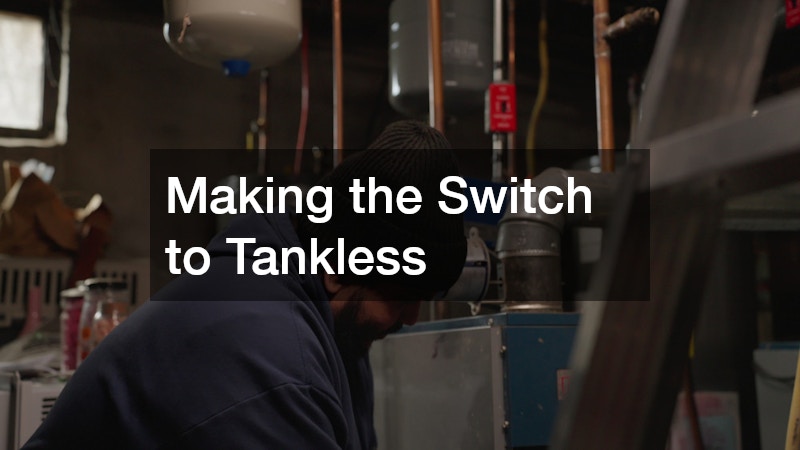Tankless water heaters have become increasingly popular among homeowners looking for a more efficient way to enjoy hot water. Unlike traditional tank-style models, these systems heat water on demand, which can provide a range of benefits. However, before deciding on a tankless water heater install, it’s important to understand how they work, what to expect, and how to get the most from them. Here are three essential things you should know before making the switch.
1. How a Tankless Water Heater Works
A traditional water heater stores a large volume of water in a tank, keeping it heated until you need it. In contrast, a tankless water heater—also called an on-demand water heater—only heats water when you turn on the tap.
When you turn on a hot water fixture, cold water flows through the unit’s heat exchanger. Gas burners or electric elements heat the water instantly as it passes through, delivering a continuous supply of hot water for as long as you need it. Once you shut off the tap, the unit stops heating water entirely.
This process eliminates the need for a bulky storage tank, freeing up valuable space in your home. It also means you’re never limited by the size of a tank—so long showers, back-to-back dishwashing, and laundry sessions can be easier to manage.
2. Benefits Beyond Space-Saving
While the compact size of a tankless system is a major draw, there are other notable benefits worth considering.
Consistent Hot Water Supply
One of the standout features of tankless systems is their ability to deliver hot water consistently. As long as your unit is sized correctly for your home’s needs, you won’t experience the temperature fluctuations often associated with older storage tank models.
Energy Efficiency
Because tankless heaters only operate when hot water is needed, they can be more energy efficient compared to systems that constantly maintain a hot water supply. Over time, this can reduce wasted energy.
Longer Service Life
Tankless units often last longer than traditional models when maintained properly. Without a large tank that can corrode over time, there’s less risk of leaks or sediment build-up affecting performance.
Reduced Risk of Water Damage
Since tankless models don’t store large amounts of water, there’s a lower chance of a catastrophic leak that can damage floors, walls, or belongings.
3. Maintenance and Installation Considerations
While tankless water heaters offer many benefits, they require proper installation and periodic maintenance to keep them performing at their best.
Professional Installation
A tankless water heater install should always be handled by a qualified professional. Proper sizing is crucial—if the unit is too small, it won’t be able to keep up with your household’s hot water demands. If it’s too large, you may end up with unnecessary energy use. A skilled technician will calculate your household’s peak hot water usage and select the right model accordingly.
Regular Maintenance
Like any appliance, tankless systems need upkeep. Mineral build-up from hard water can accumulate inside the heat exchanger, affecting efficiency and lifespan. Most manufacturers recommend flushing the unit annually or more often in areas with very hard water. This process helps remove scale and keeps the heating elements or burners working efficiently.
Venting and Location
Gas-powered tankless water heaters produce exhaust gases during operation, which means proper ventilation is essential for both safety and performance. Without the right venting setup, harmful combustion byproducts like carbon monoxide can accumulate indoors, posing serious health risks. Most units require either stainless steel vent pipes or a sealed direct vent system that draws fresh air from outside and expels exhaust safely away from the home. The exact requirements will depend on the model and local building codes, so it’s important to work with a qualified installer who can ensure everything meets regulations.
The location of your tankless water heater plays an equally important role in efficiency and convenience. Ideally, the unit should be installed in an area where technicians can easily access it for regular maintenance and repairs. Placing it too far from your main water fixtures can lead to delays in hot water delivery, as water has to travel longer distances through the pipes. In some cases, homeowners choose to install multiple units closer to high-demand areas—such as one near the kitchen and another near bathrooms—to reduce wait times and improve overall efficiency. Additionally, for outdoor installations, the unit should be protected from extreme weather conditions to prevent damage and ensure consistent performance year-round.
Making the Switch to Tankless
If you’re considering upgrading your water heating system, a tankless water heater can offer lasting benefits in performance, efficiency, and convenience. Before committing, weigh the pros and cons, think about your household’s hot water usage, and consult with a licensed professional who can guide you through sizing and installation.
A tankless water heater install isn’t just about replacing an old system—it’s about choosing a solution that matches your home’s unique needs and enhances your daily comfort. With the right model and proper maintenance, you can enjoy reliable hot water for years to come without the limitations of a traditional tank.



